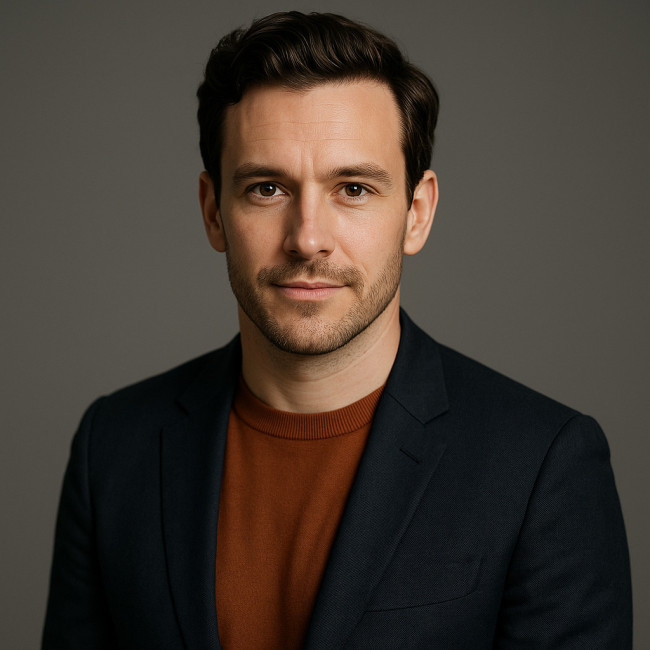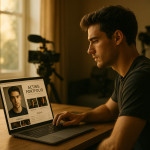Selecting headshots: colour, framing and mood that win casting directors' eyes
Your headshot is your silent pitch: in a fraction of a second, casting directors decide whether you fit the brief. Learn how colour palettes, framing choices and emotional cues combine to make headshots that get shortlisted, booked and remembered.
Why modern headshots need more than a smile
Casting teams scroll hundreds of thumbnails per day. A standout headshot delivers three promises at once: professional quality, character range and brand consistency. When those elements align, you move straight to the director's shortlist instead of blending into the feed.
Colour strategy: backgrounds and wardrobe that pop without distracting
Understand how the human eye scans thumbnails
Neuroscience studies show that warm hues (red, coral, mustard) pull focus faster than cool tones. Yet over-saturated reds can clip on low-quality screens. Stick to mid-tone walls or seamless paper and complement them with wardrobe accents that frame your face.
Table – Popular background colours and their casting impact
| Colour | Ideal Character Types | Risk Level | Pro Tip |
|---|---|---|---|
| Light Grey | Corporate, Legal, Contemporary Drama | Low | Lift shadows with a silver reflector for clear eyes. |
| Soft Blue | Rom-Com, Medical Roles | Low | Avoid denim shirts; they merge with backdrop. |
| Warm Beige | Period Pieces, Historical Adaptations | Medium | Add subtle hair back-light to avoid flatness. |
| Bold Teal | Action, YA Series | High | Match wardrobe pocket square or earrings only. |
| Crimson | Villain, High-Fashion Roles | High | Book extra retouch time to control skin-tone shifts. |
Wardrobe colour rules that flatter skin tones
- Neutral top + subtle accent = safest combo for all briefs.
- Avoid pure white unless the backdrop offers strong contrast.
- Layer textures (e.g., knit over cotton) to add depth without patterns.
Framing fundamentals: crop sizes that sell versatility
Industry standards evolve. A decade ago, 8×10” verticals ruled. Today, directories, including new-portfolio listings on Artfolio, auto-crop to square or 4:5 ratios. Shoot extra space around the crown and shoulders so your look survives every platform.
Cinematic vs. classic framing
Cinematic 16:9 crops read well on mobile showreel intros. Classic portrait orientation still dominates printed comp cards. Deliver both to your agent and upload the square hero image to your own page. That synergy feeds the algorithm and human eyes alike.
Lens choice and distance
A 85 mm prime at 1.8 m distance keeps features true. Wider lenses exaggerate noses; longer lenses flatten emotion. Ask your photographer to shoot series at 70 mm, 85 mm and 105 mm, then compare expressions side-by-side before you commit.
Mood direction: convey story in one glance

Emotion beats aesthetics. Casting assistants tag images by “approachable”, “authority” or “quirky friend”. Plan three micro-scenes: Audiences subconsciously map facial cues to familiar screen archetypes; even a half-millimetre eyebrow lift can signal mischief, while a softened jaw communicates vulnerability. Before the shutter clicks, rehearse the intention behind each expression, visualise the scene partner you are addressing and breathe into the emotion so that your eyes carry authentic story beats.
- Neutral warmth – slight smile, relaxed brow, ideal for hero image.
- Determined focus – squint just enough to suggest grit.
- Playful spark – asymmetrical expression, hint of improvisation.
Rotate wardrobe and lighting subtly between moods to multiply usable shots without booking extra studio time.
Lighting setups that flatter every skin tone
Key + fill ratio
2:1 lighting (key twice as bright as fill) keeps cheekbones defined while avoiding harsh drama. Darker skin tones often benefit from an added hair light to separate silhouette.
Practical gear list
- Large octabox (90 cm) for soft, wraparound highlights.
- White V-flat reflector for adjustable fill on location.
- LED panel at 5600 K for consistent colour in mixed environments.
Retouching ethics: real vs. plastic
Erase flyaway hairs and minor blemishes; keep smile lines and iris texture. Over-polished skin reads as CGI on 4K monitors. Aim for a “best day” version of yourself, not a magazine cover. A natural finish supports the authenticity that profile-scanning directors expect.
File delivery checklist that speeds up submissions
- JPEG, sRGB, 3000 px on the longest side.
- Optional TIFF for print comps.
- Rename files: Lastname_Firstname_RoleType_Color.jpg for easy database search.
- Add alt text descriptions: “Headshot of John Doe in soft blue shirt on grey background looking confident”. This boosts discoverability in SEO-driven casting pages.
Upload strategy: keep your gallery fresh
Refresh hero headshots every 18 months or when your hair length changes by more than 5 cm. Drop the new image at the top of your gallery to trigger algorithmic boosts and signal activity to agents. Pair it with a one-minute showreel overhaul using tips from this editing guide.
Quick self-assessment quiz
FAQ
- How many headshots should I upload to my casting profile?
- Three to five. Include a neutral hero, two contrasting moods and a full-body shot for physicality.
- Can I shoot my own headshots with a phone?
- Modern phones handle resolution, but lighting, lens compression and professional direction still separate amateurs from bookable talent.
- Should I smile in every headshot?
- No. A genuine half-smile for approachability plus a serious look for authority covers most briefs.
- How often should I update my headshot?
- Every 12–18 months, sooner if you change hairstyle, lose/gain notable weight or age out of a playing range.
- Matte or glossy prints for hard-copy submissions?
- Matte absorbs light and avoids fingerprints; most agents prefer it for in-person auditions.
Take action now
Schedule a session with a photographer who understands casting trends, prep three wardrobe options and plan your expression storyboard. A fresh, strategically coloured and well-framed headshot is the quickest win on your path to more auditions.
Ready to upgrade? Start with your gallery refresh today and watch your callback rate climb.











